The Early Years (2004-2008)
In La Masia and the Barcelona B team, Lionel Messi played mostly on the left wing or as a number 10. Messi said he saw himself as a typical Argentine Enganche; a playmaking number 10 who sits in the hole between the midfield and attack.
When he broke through into Barca's first team however, Ronaldinho generally operated from the left and Eto'o played centrally in Barca’s 4-3-3, so Messi was played on the right wing where he shared game time with Ludovic Giuly.
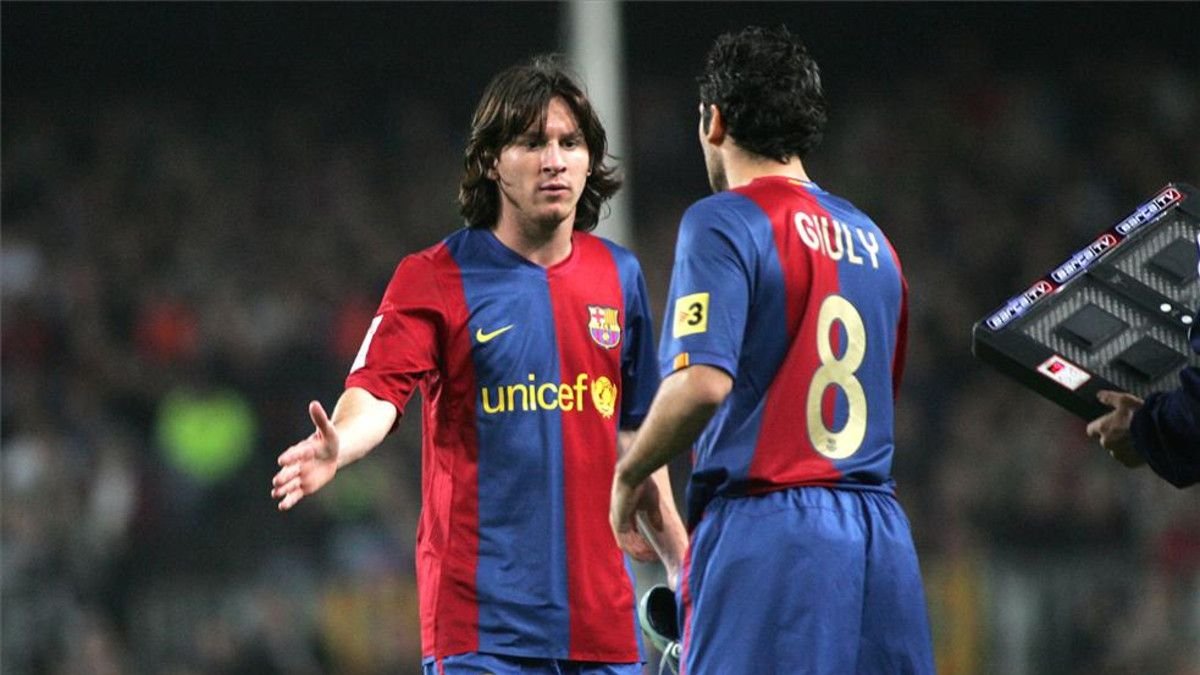 Leo Messi initially shared playing time on the right wing with Ludovic Guily
Leo Messi initially shared playing time on the right wing with Ludovic Guily
At this early stage of his career he was a pure dribbler who would aim to beat defenders and get to the by-line before trying to find Eto’o or Ronaldinho.
 Messi as a right winger under Rijkaard
Messi as a right winger under Rijkaard
As time went on, he dribbled into central areas more often and gained the confidence to take shots at goal more regularly, resulting in steadily increasing goal returns in these first few seasons.
The False 9 Years (2009-2014)
When Pep Guardiola took over in 2008/09, he gradually started to play Messi centrally more often, but not as a number 10 behind a centre-forward.
Samuel Eto’o was often pushed out onto the right with Henry on the left, creating a “strikerless” 4-3-3 system in which Messi would function as a False 9.
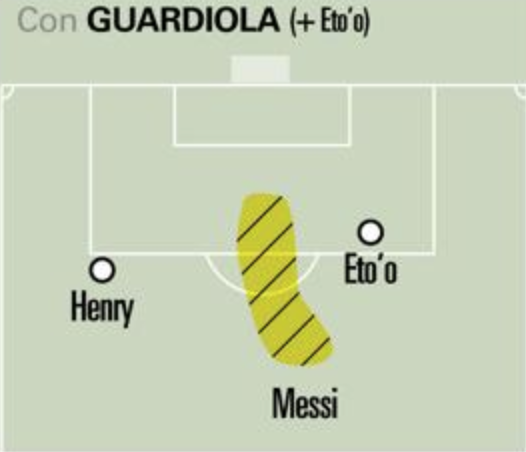 The beginning of Messi's False 9 phase under Pep Guardiola
The beginning of Messi's False 9 phase under Pep Guardiola
This allowed Messi to use his skills as a number 10 to drop deep and act as playmaker for the wide men, as well as fulfilling centre-forward duties in the final attacking phase.
In 2009/10, Messi still often started on the right following the signing of a more traditional centre-forward in Zlatan Ibrahimovic, but it soon became clear that Guardiola preferred Messi in the central position.
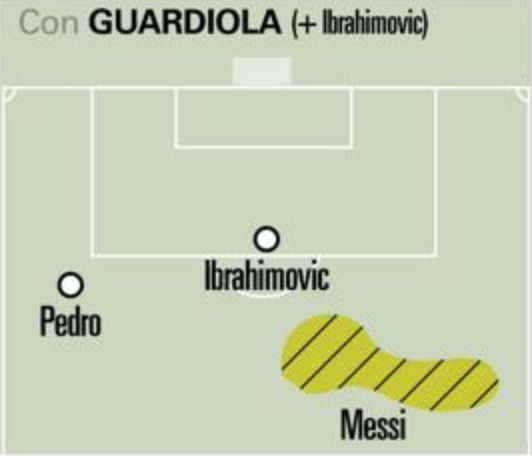 Messi again spent time on the right when Ibrahimovic was brought in for 2009/10
Messi again spent time on the right when Ibrahimovic was brought in for 2009/10
Ibrahimovic was offloaded after just one season in Barcelona, leaving Messi to play the central False 9 role for the next 4 seasons from 2010/11, even after Guardiola’s departure in 2012.
This period was undoubtedly where we saw the best of Messi and his vast skillset.
The nature of the false 9 role saw Messi drop deep between the opposition midfield and defence, meaning the centre backs either went with him giving him the opportunity to play defence-splitting passes for the wide forwards running in behind, or they would hold their position and allow him the space to dribble directly at them. It also meant that in the final phase of attacks, Messi was the centre-forward who could get on the end of moves (that he often started) inside the penalty area.
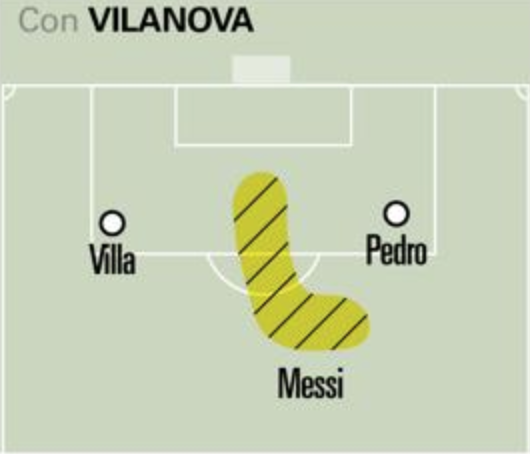 Messi continued in the False 9 role under Tito Vilanova, flanked by David Villa and Pedro
Messi continued in the False 9 role under Tito Vilanova, flanked by David Villa and Pedro
So the false 9 version of Leo Messi enabled his best qualities to shine with incredible regularity; his passing, his dribbling, and his finishing.
His quality and dizzying goalscoring numbers saw him win 4 consecutive Ballons d'Or during this period.
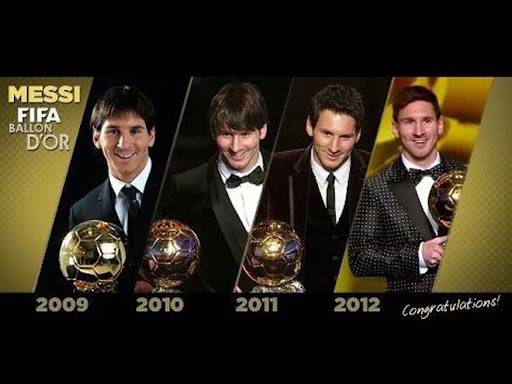 Messi won a record 4 consecutive Ballons d'Or from 2009 to 2012
Messi won a record 4 consecutive Ballons d'Or from 2009 to 2012
The MSN era (2014-2017)
In 2014 we saw the next major shift in Messi’s position/role with the arrival of Luis Suarez.
Barcelona would still line up in a 4-3-3, but now Suarez would operate as a more traditional centre-forward as opposed to the false 9 system they had previously deployed.
Messi was therefore moved back out to the right wing, although this was more just a starting position.
With Suarez playing as an orthodox striker, he would stretch the opposition and occupy the centre-backs by playing on the shoulder looking to run in-behind.
This in turn would create space for Messi to move inside and perform number 10 duties, combine with the overlapping Dani Alves on the right, and loop lobbed balls to Alba on the left. Not forgetting the often mesmerising interplay with Neymar who would move in from the left.
The famous MSN trio was a dynamic and fluid front line, with lots of interplay and interchanging. All three players enjoyed outrageous output, with a jaw-dropping 364 goals between them in the 3 seasons they shared together.
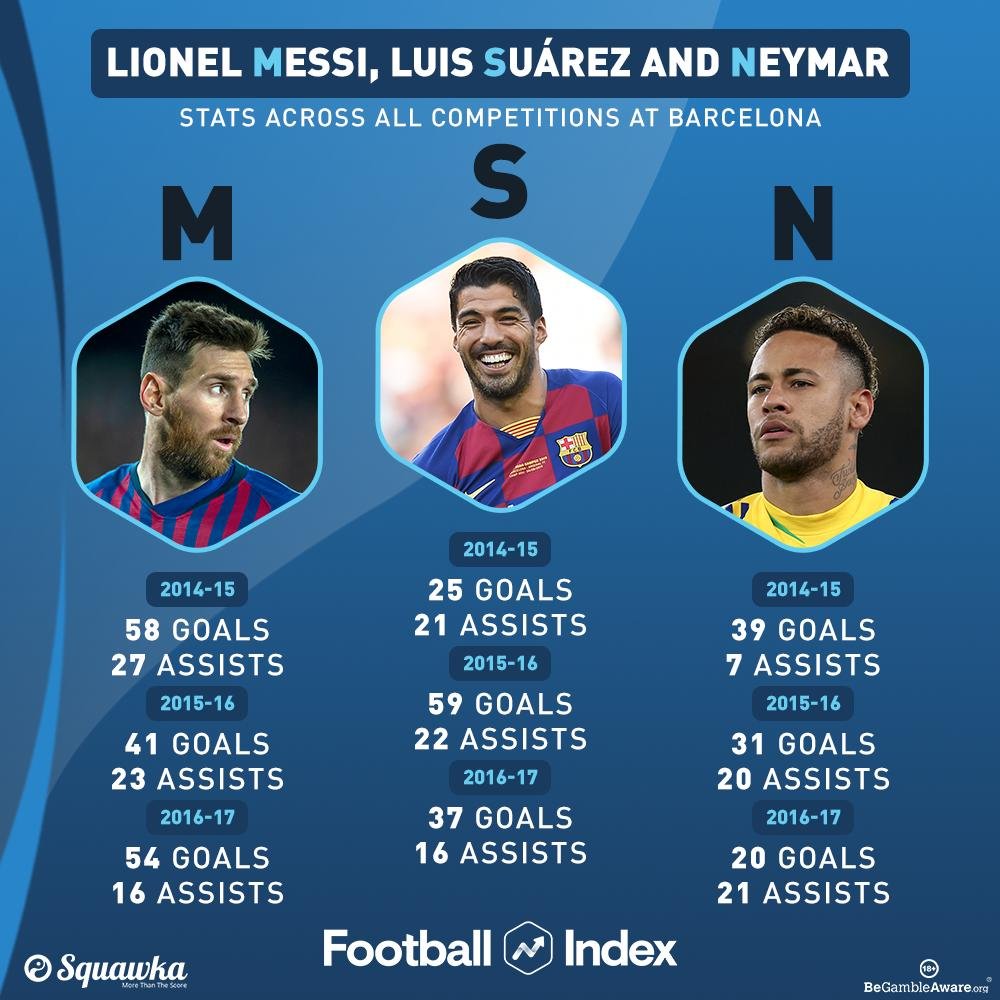 The MSN trio recorded some jaw-dropping stats in their time together at Barcelona
The MSN trio recorded some jaw-dropping stats in their time together at Barcelona
The Final Barca Years and Beyond (2017 - Present)
Since Neymar and Luis Enrique left Barcelona in 2017, we've seen 3 different managerial reigns with Valverde, Setien and Koeman.
Barca’s attack has also been much less settled, with the likes of Dembele, Coutinho, Vidal, Griezmann, Fati (among others) coming in and out of the side.
As a result, Barca’s formation and Messi’s starting position has essentially depended on the personnel in the lineup on any given day.
Sometimes he would be up front alongside Suarez or Griezmann, sometimes behind both ‘in the hole’, occasionally in the False 9 role, and often on the right.
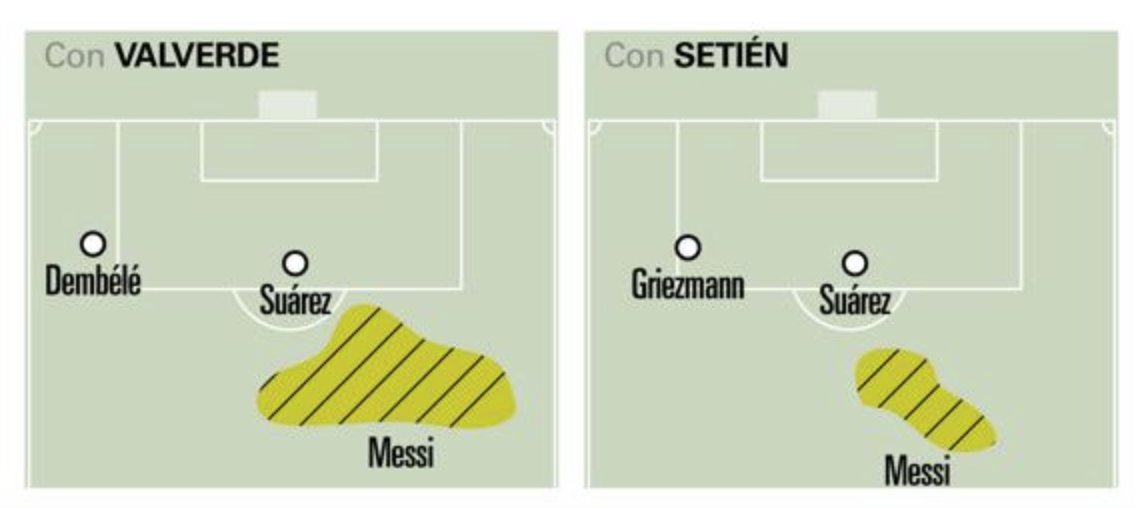 Messi was often back on the right under Valverde and Setien, but regularly drifted inside
Messi was often back on the right under Valverde and Setien, but regularly drifted inside
In the last few seasons, we’ve seen a greater proportion of Messi’s involvement coming in the area of the pitch between the centre circle and opposition box, sometimes on the right but mostly in central areas.
As a result, his inside the box shots per 90 dropped to below 3 in the league in each of the last 4 seasons (including 21/22). In those 4 seasons he has also taken more shots per 90 outside the box than inside.
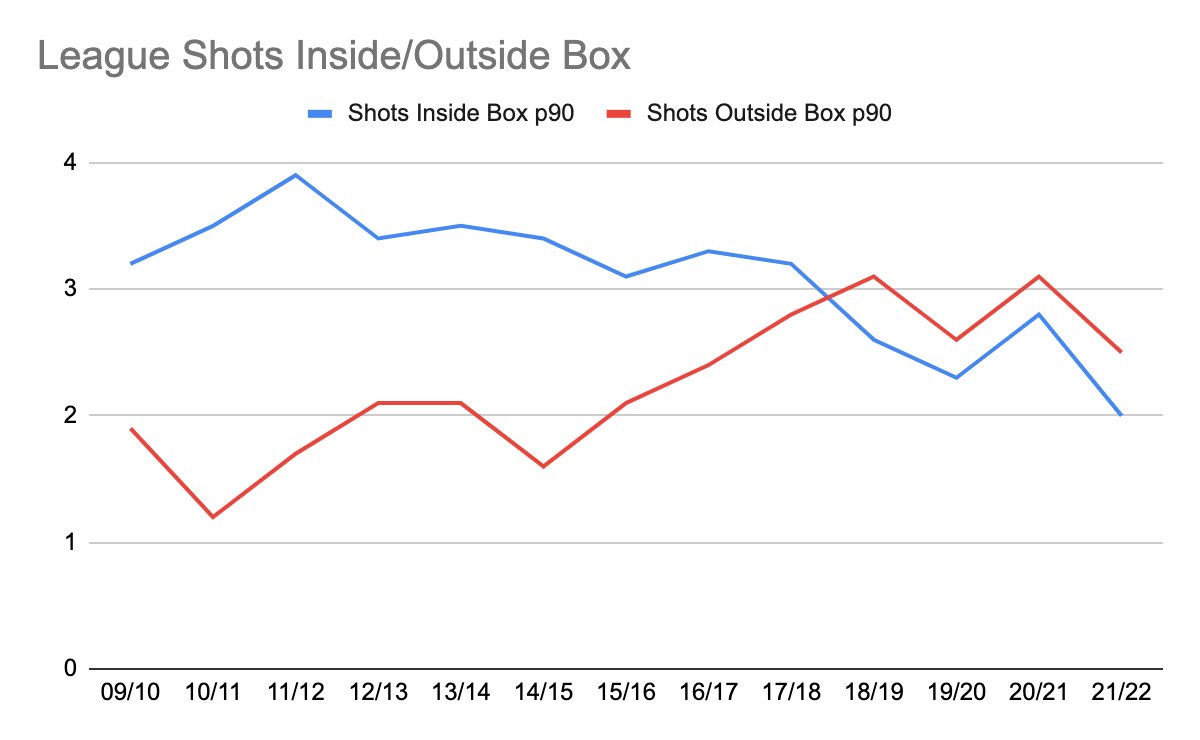 Messi now takes more shots outside the box than inside (up to 1/1/2022)
Messi now takes more shots outside the box than inside (up to 1/1/2022)
As Leo Messi moves into the twilight of his career, we can probably expect to see this trend continue, with less focus on assuming the CF role getting on the end of moves in the box, and more focus on progressive plays and shooting from deeper positions.
In Summary
To summarise, Messi started out as a left winger / CAM in his youth days (< 2004), but was soon converted to a right winger after making his professional debut (2004 - 2009).
He then enjoyed his most productive spell in the central False 9 role (2009-2014), before being utilised in a wide range of attacking roles in the following years (2014 - present), including back on the right wing, number 10, second striker and occasional False 9 reprisal.
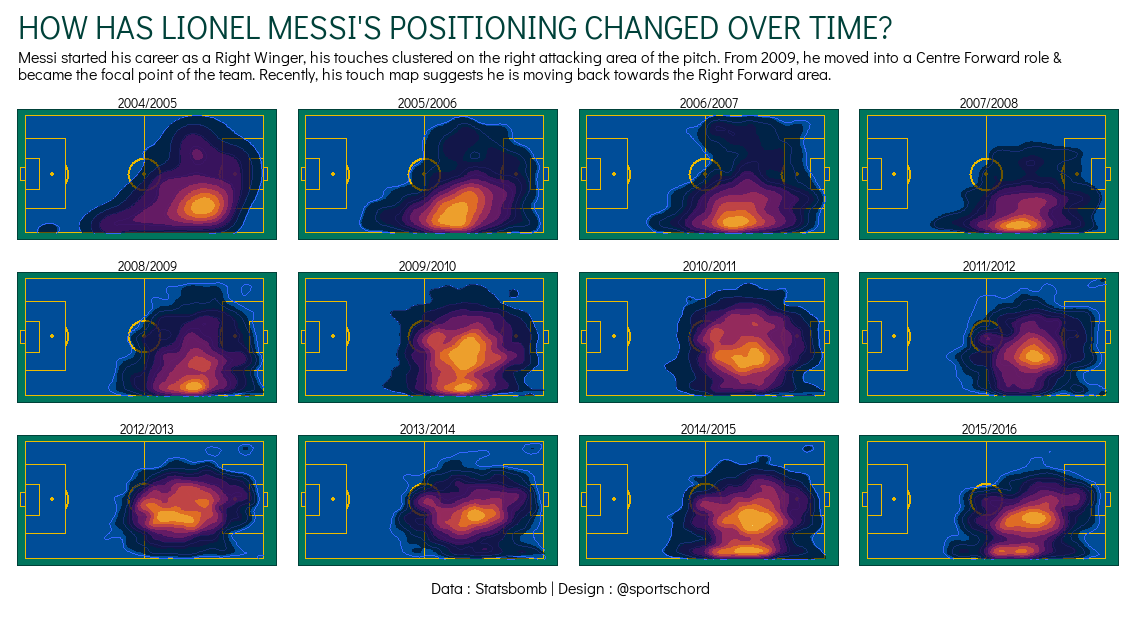 How Messi's primary position has evolved over the years
How Messi's primary position has evolved over the years

